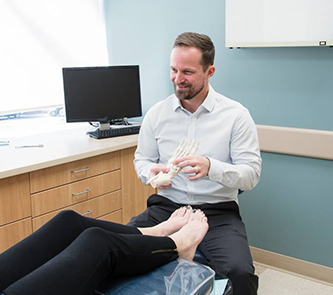Sports Injuries
Maybe you get out and get active just for fun. Maybe you do it to be competitive—either against others or against your own personal bests.
(We totally get that competitive part. Some of our doctors like to race the clock and others outside the office!)
Sports and physical activity can feel greatly freeing and provide a big, positive rush. That’s why it can always be such an ordeal when a sports injury gets in the way of doing what you love. You might even start to weigh your options: do I do something about this or just grit my teeth and get back in?
We know how it feels, but we beg you: Don’t ignore sports injuries—especially to your feet and ankles! Contact our experts in Portsmouth and Nashua.
No Pain, Better Gain
We’ll come out and say it: Whoever said “no pain, no gain” really needed to put an asterisk on that statement.
The temporary ache of your muscles after a workout is fine, but strong or lasting pain is not going to benefit you in any way. In fact, trying to continue through such pain is likely to set you up for a chronic, performance-ruining condition!
Think of it like this: you wouldn’t continue driving on a tire that sprung a leak before getting it fixed, right? You’d risk a blowout! Only with you, that blowout could be your Achilles tendon, plantar fascia, heel bone, or something else you definitely need to get around.
Treatment for a sports injury may take some time, but we promise to help you get back to activity as fast (but safely!) as possible. Some recovery time now is much better than the need for extended time—or even surgery—in the future.
Types of Sports Injuries

While some sports injuries such as sprains and fractures tend to come from a strong, one-time force (we likely don’t have to explain these much), many more fall under the umbrella of “overuse injuries.”
Overuse injuries are the result of pushing your body too hard with extensive, repetitive motions or impacts. The body has a natural ability to rebuild itself when you wear it down and cause minor tears and injuries in its tissues. If you don’t allow your body the time it needs to do so these tiny injuries will stay and build up to a problem.
Some kinds of overuse injuries include:
- Stress Fractures – Small, hairline cracks that can form in the surface of a bone due to overuse. This is common in runners and other high-impact aerobic activities, and can happen in just about any bone of the foot from the heel bone to the metatarsals.
- Plantar Fasciitis – Each foot has a thick band of tissue that runs along the underside—the plantar fascia. It provides support to the arch of the foot, but can develop small tears and become inflamed with excessive use. The end result is an often sharp, stabbing form of heel pain that is worst when getting up in the morning or after a long period of inactivity.
- Achilles Tendonitis – An inflammation of the Achilles tendon, located toward the back of your heel bone. Pain from this condition tends to be located just above the back of the heel, and often comes with a tangible bump as well. In worse cases, the Achilles tendon might develop a tear or rupture completely.
- Shin Splints – This pain develops along the front of the lower leg, against the shin bone although it can sometimes be felt along the inside of the lower leg as well. This is another common running injury, especially in those who have increased the distance or number of their runs too quickly.
There are many other sports injuries your feet and ankles can face, including black toenails, tarsal tunnel syndrome, and sesamoiditis. Properly identifying the cause of your discomfort is the biggest key in receiving the proper treatment.
Overcoming Sports Injuries
Our podiatrists at Northeast Foot and Ankle are well versed in sports injury treatment, and keep an athlete’s lifestyle and needs in mind when recommending the best course of action.
Rest is a common requirement for recovery in many cases, and following the guidelines is the best way to ensure the quickest recovery without additional problems. That doesn’t necessarily mean you’ll be on the couch with your foot up all the time, though! With guidance, lower-impact exercises like swimming or cycling may be recommended to keep your body moving without placing force on your injury.
In some cases, especially with soft tissue injuries, we may also recommend MLS laser and Extracorporeal Pulse Activation Technology (EPAT) treatments or platelet rich plasma (PRP) injections to encourage accelerated healing and reduce inflammation in the site of trouble.
Custom orthotics might also properly align the structure of the foot and ankle to keep extra force off a problematic area, reducing pain and helping to prevent re-injury. Physical therapy, including stretches for tendons and calf muscles, may also become part of a regular routine. We will show you how it’s done.
If you have run into a fierce opponent in the form of a sports injury to your foot or ankle recently, we want to join your team and get you back on top again. Call us at (603) 431-6070 to schedule an appointment at our offices in Nashua or Portsmouth. Serving all of New Hampshire whether you’re from Kensington, Hampton Falls, Seabrook, or anywhere in between.
Pay Your Bill
Make a payment online through our payment portal or Care Credit!
Portsmouth Office
14 Manchester Square, Suite 250
Portsmouth, NH 03801
Nashua Office
17 Riverside Street, Suite 205
Nashua, NH 03062
Website Hosted by SC Digital



